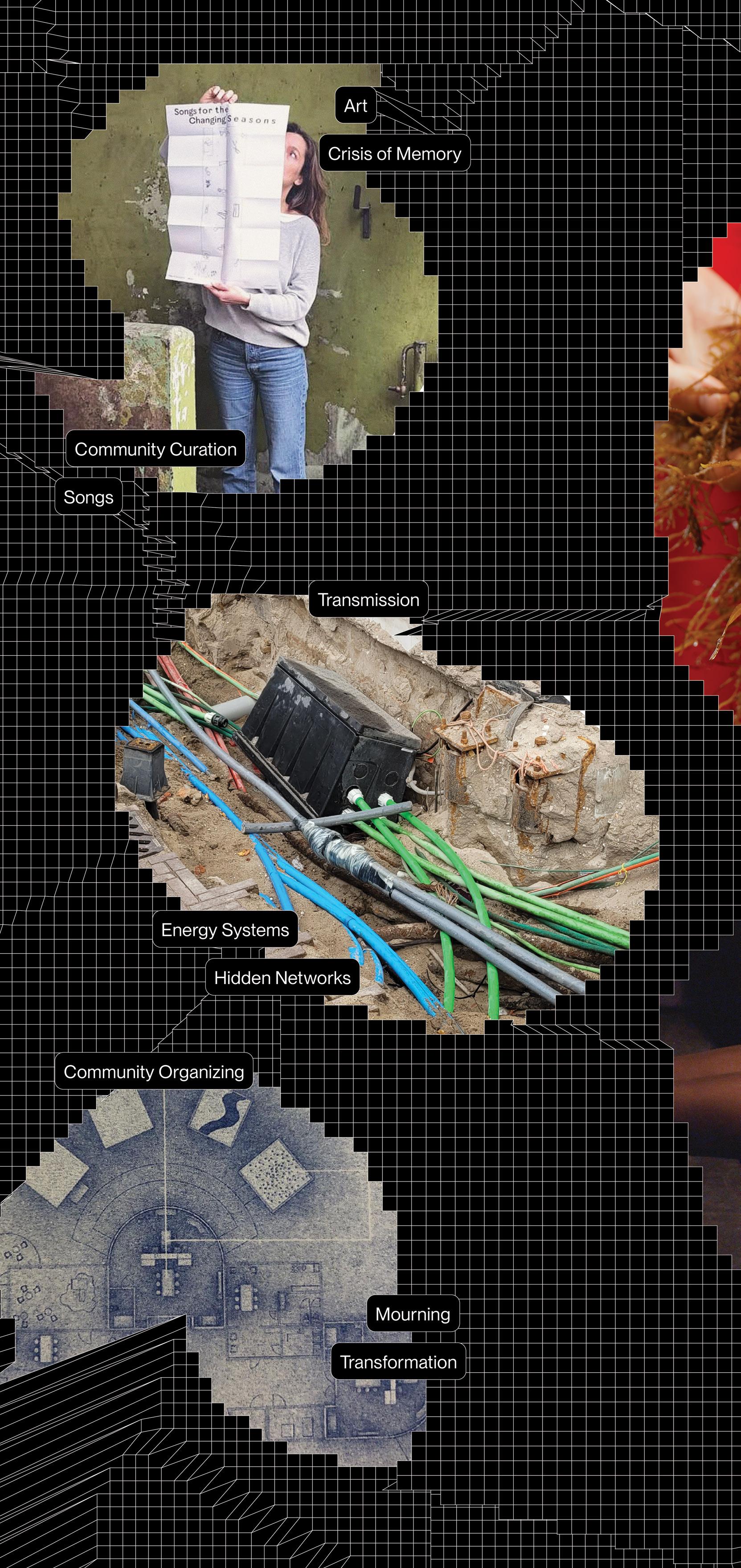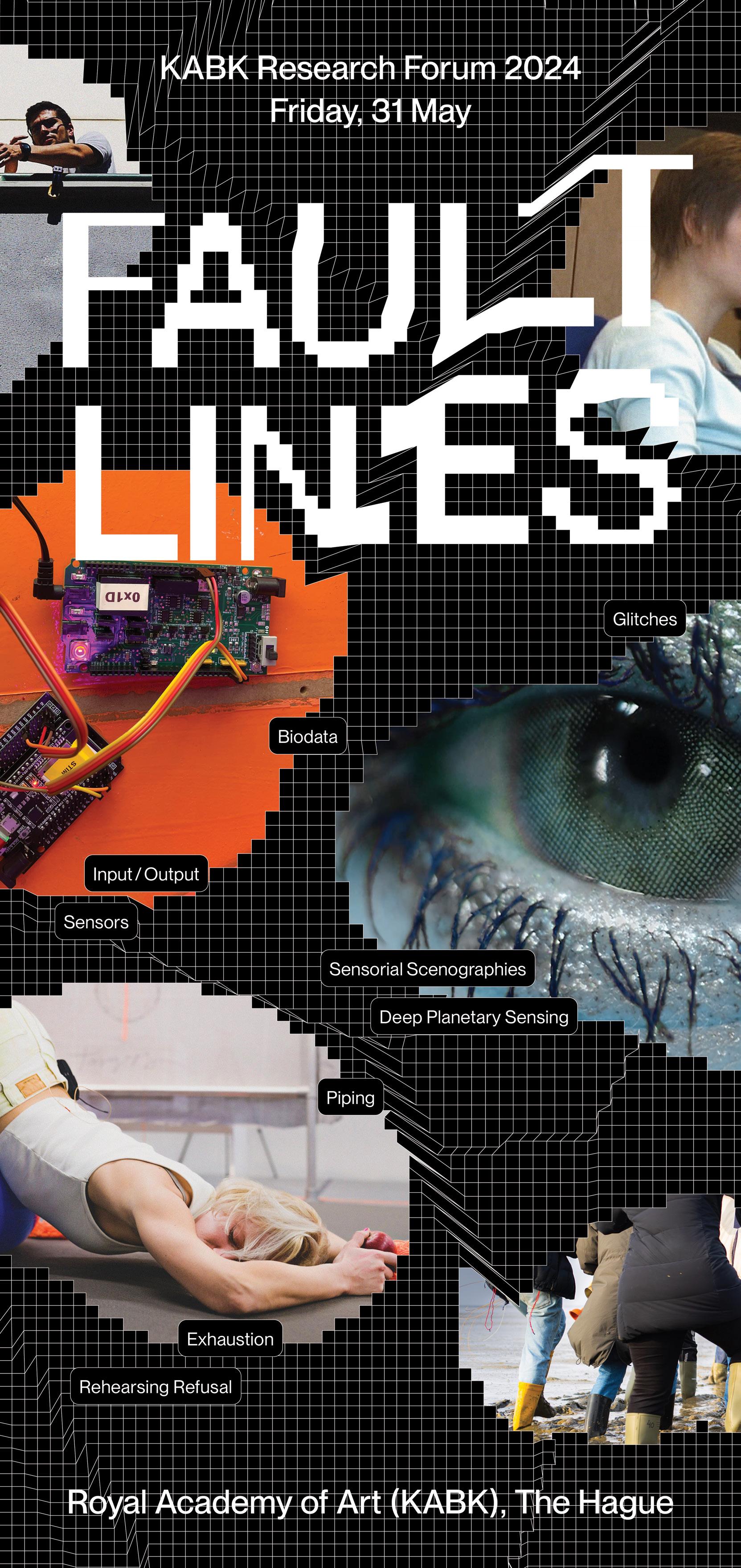
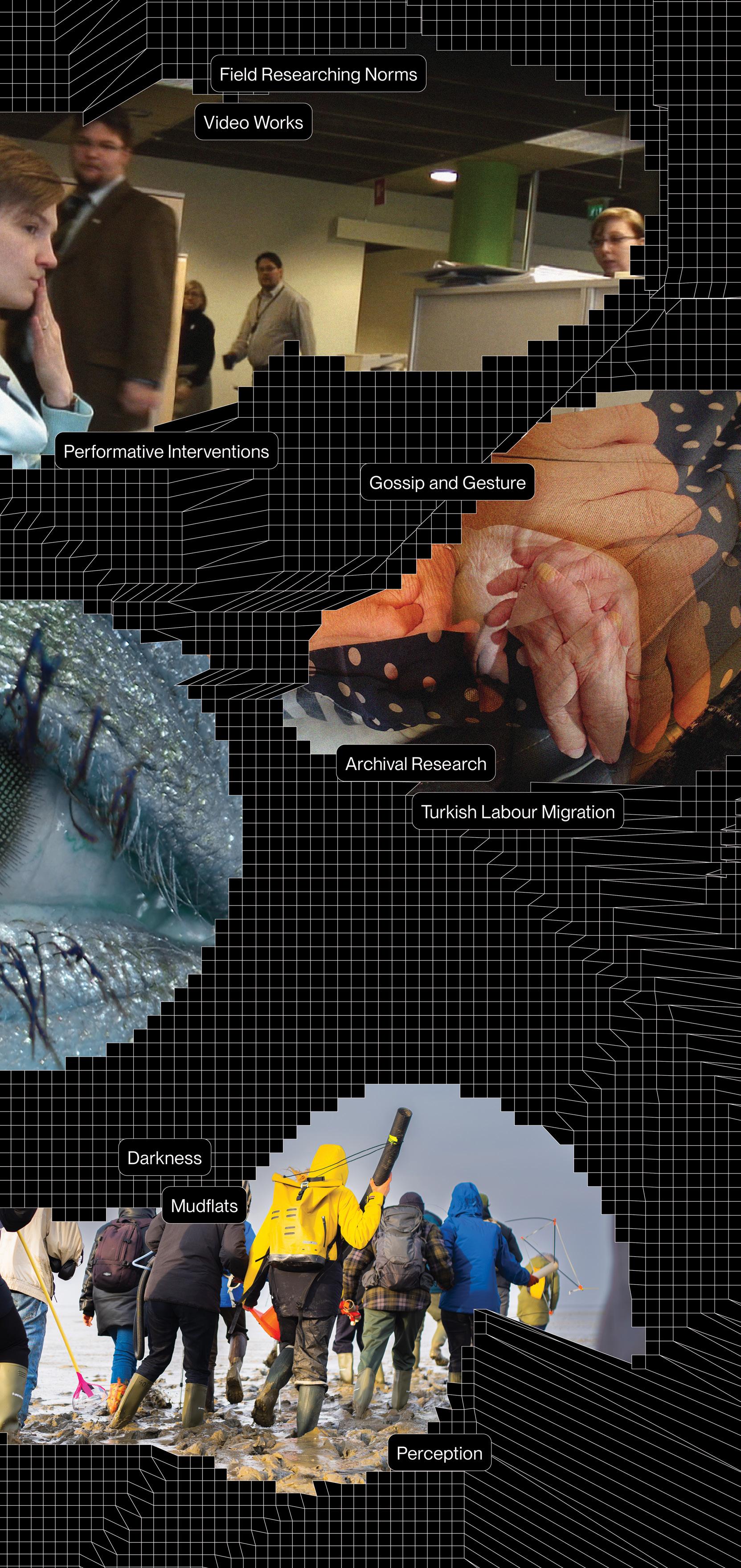
11:00 KABK Design Lector, Alice Twemlow, Introduction
REHEARSING REFUSAL: RESEARCHING WITH THE BODY
11:20 Invited speaker-respondent, Pilvi Takala
11:40
Deep Futures Research Group member, Noa Marthe Prins, ‘If Not a Worker, Who am I?’
12:00 Invited speaker-respondent, Staci Bu Shea
12:20
Deep Futures Research Group member, belit sağ, ‘Sonic Embodiments and the Veghel Labor Dispute’
12:40 Critical feedback and moderated discussion
13:30 Lunch break
TRANSDUCING: RESEARCHING WITH ENERGY
14:30 Invited speaker-respondent, James Auger
14:50
Deep Futures Research Group member, Boudewijn Buitenhek, ‘New Measures for Energy Use in Artistic Practice’
15:10 Invited speaker-respondent, Annika Kappner
15:30 Deep Futures Research Group member, Marlot Meyer, ‘Sensitive Systems: Alternative Methods for Mapping Bodies’
15:50 Critical feedback and moderated discussion
16:30 Tea break
RE-ENCHANTING: RESEARCHING WITH THE MORE THAN HUMAN
17:00 Invited speaker-respondent, Kate Scardifield
17:20
Deep Futures Research Group member, Cocky Eek, ‘Dark Skies and the Art of Dreaming’
17:40 Invited speaker-respondent, Filipa Ramos
18:00 Deep Futures Research Group member, Georgie Brinkman, ‘We are Sky-Breakers’
18:20 Critical feedback and moderated discussion
19:00 Drinks reception, KABK Courtyard
4
Welcome to Fault Lines: KABK Research Forum 2024, the sixth edition of an annual event that invites the extended KABK community to connect with the research generated through the Design Lectorate Deep Futures Research Group.
At the centre of the Design Lectorate is a collective and ongoing research project that aims to contribute alternative imaginaries to the reservoir needed for the sensory, emotional and intellectual compositing of equitable climate futures. As such, the project is situated at the intersection of environmental humanities, practice-based research and design history and aims to add knowledge to, and benefit from exchange with, each of the disciplines that it touches.
Each year the KABK makes provision for a selected group of its tutors and staff to work on self-defined research projects. The approaches range from research driven by and through an artistic or design practice to academic research in preparation for a PhD-trajectory and from material or technological research to theoretical and philosophical inquiry. Among the numerous research methods we like to experiment with are: walking-with, research through materials and matter, collective writing and messaying, critical collaging, listening, iterative prototyping, re-enacting, and mapping.
We meet every few weeks at each other’s sites of research practice where we discuss recent experiments, read texts, write, and think with each other through the doubts, dilemmas and complexities of our individual projects and the methodological or thematic composite that links them. The year concludes with the participants sharing aspects of this research process with colleagues, peers, students, research companions, as well as invited external speaker-respondents.
We are grateful for your participation in this day of exchange centred on our individual projects and collective thinking around art, design, research and climate justice and look forward to continuing the conversation well into the near, if not the deep, futures.
Alice Twemlow, Design Lector
5
Dr. James Auger
James Auger is director of the design department at the École Normale Supérieure Paris-Saclay (ENS), co-director of the Centre de Recherche en Design (ENS / ENSCI Les Ateliers) and an Associate Professor at RMIT Europe. His work explores ways through which practice-based design research can lead to more considered and democratic technological futures.
James has an MA in Design Products and a PhD in practice from the Royal College of Art. Between 2005 and 2015 James was part of the critically acclaimed Design Interactions department at the RCA, teaching on the MA programme and continuing his development of critical and speculative approaches to design and technology. After stints at Media Lab Europe (MLE) in Dublin and the Issey Miyake Design Studio in Tokyo, James founded the Reconstrained Design Group at Madeira Interactive Technologies Institute (M-ITI) in Portugal, exploring the potential of the island as an experimental living laboratory through a combination of fictional, factual and functional multi-scale energy-related proposals and projects. This work was awarded the Cultural Innovation International Prize by the Centre of Contemporary Culture of Barcelona (CCCB) in 2017.
Running parallel to his academic work James is a partner in the speculative design practice Auger-Loizeau, with its projects published and exhibited internationally, at MoMA, New York; 21_21, Tokyo; The Science Museum, London; The National Museum of China, Beijing and Ars Electronica, Linz, among others.
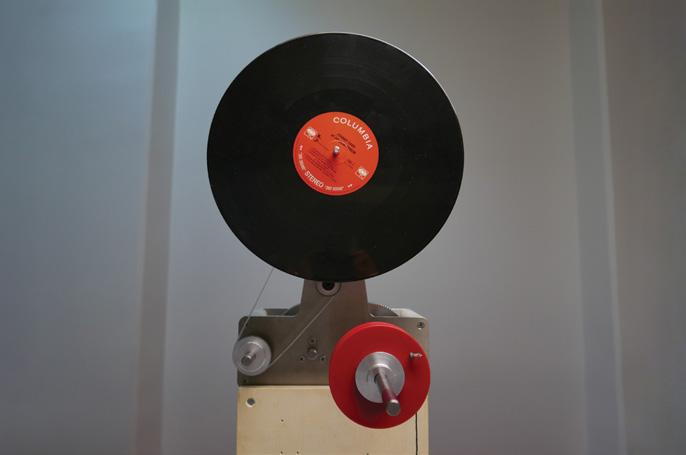
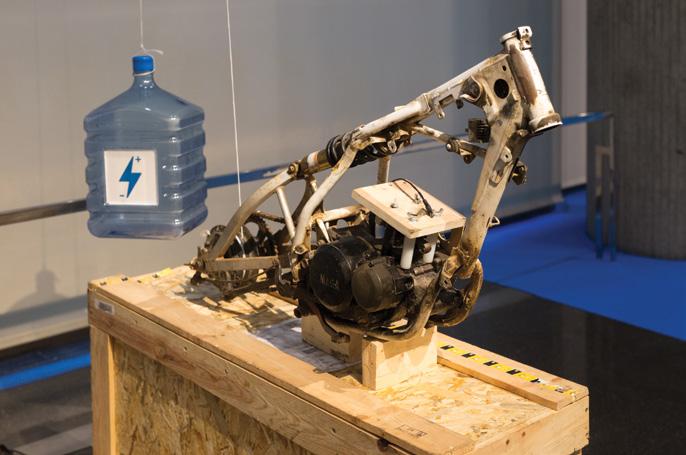
6
Turntable prototype, from Reconstrained Design project by James Auger. Image credit: Julian Hanna
Gravity Battery prototype, version 3, from Reconstrained Design project by James Auger. Image credit: Julian Hanna
Annika Kappner
Annika Kappner is a Berlin-born and Amsterdam-based visual artist and researcher. Within the field of expanded painting, Annika creates sensory scenographies that combine landscape, installation, performance, guided meditation, scent and sound to generate glitches in perception.
Annika’s multidisciplinary practice explores the interconnected evolution of consciousness and archetypal imagery, as well as its reflection on the shifting perception of (self) image and The Other. The artist’s research approach is participatory and collaborative, intertwining rational analysis and her own background in finance with embodied experience and intuition.
Her work layers experiential perspectives unto the relationship between human, nature and technology, and addresses concepts of non-duality and otherness, to encourage the emancipation of our way of sensing our surroundings.
Annika’s ongoing and ever-evolving research project, ‘Deep Planetary Sensing’, has been in development since 2019. Additionally, she is a co-founder of the artist collective Elephants & Volcanoes and co-curator of the Holistic Technology Salon at V2, Lab for Unstable Media, a series of community events and podcasts that explore alternative forms of relating technosphere through the somatic and ultrasensorial.
Her work has been exhibited in the Netherlands at Het Nieuwe Instituut, IMPAKT, Marres House for Contemporary Art Maastricht, MBOT, and Sonic Acts, and internationally at Bienal Internacional de Arte Amazónico (PE), National Museum of Natural History, Menton (FR) and Rush Arts Gallery, New York (US).
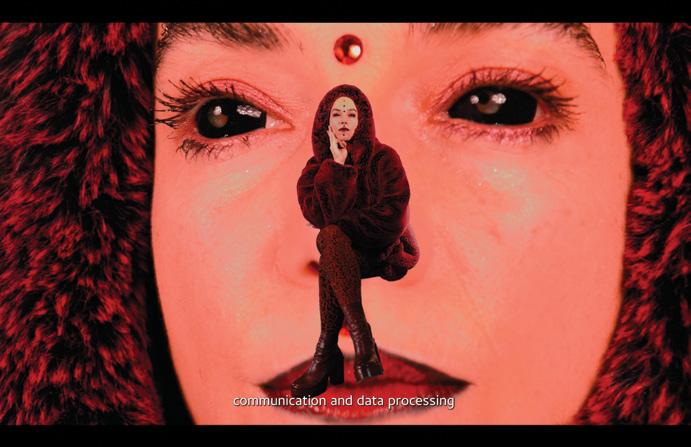

7
Ater Tumti, multimedia installation by Annika Kappner for Sonic Acts 2024. Image credit: Annika Kappner
Ater Tumti, Annika multimedia installation by Annika Kappner for Sonic Acts 2024. Image credit: Pieter Kers.
Dr. Filipa Ramos
Filipa Ramos is a writer and curator. She is a lecturer at the Arts Institute of the HGK/FHNW, Basel. Her research focuses on how contemporary art engages with nature and ecology. Filipa is curator of the Art Basel Film sector and a founding curator of the online artists’ cinema, Vdrome.
Current projects include BESTIARI, the Catalan representation at the 60th Biennale di Venezia (2024) and the arts, humanities and science festival The Shape of a Circle in the Mind of a Fish (since 2018, with Lucia Pietroiusti). In 2024, she curated Songs for the Changing Seasons for the first Klima Biennale Wien (with Lucia Pietroiusti), In 2022, Persons Persone Personen, the 8th Biennale Gherdëina (with Lucia Pietroiusti). In 2021, she co-curated Bodies of Water, the 13th Shanghai Biennale (with Andrés Jaque, Lucia Pietroiusti, Marina Otero Verzier and Mi You).
Filipa was editor-in-chief of e-flux criticism (2013-20), associate editor of Manifesta Journal (2009-11) and contributor for Documenta 13 (2012) and 14 (2017). She authored Lost and Found (Silvana Editoriale, 2009) and edited Animals (Whitechapel Gallery/MIT Press, 2016). Her upcoming book, The Artist as Ecologist, will be published by Lund Humphries in 2024.

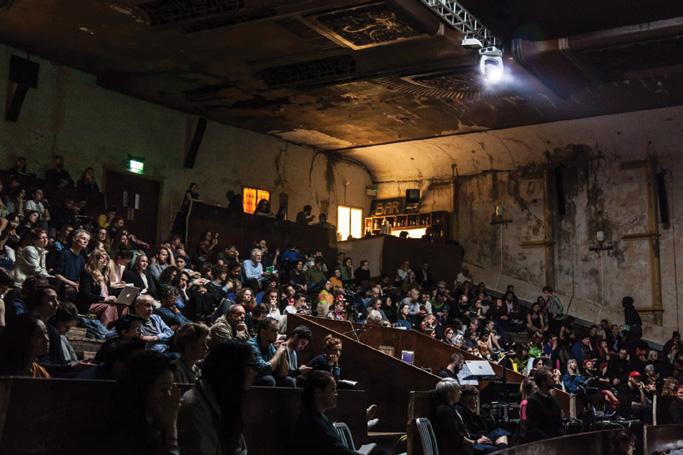
8
A peacock looking at a drawing by Joan Jonas. Image credit: Filipa Ramos.
Audience at The Shape of a Circle in the Mind of a Fish With Plants, co-curated by Filipa Ramos, EartH Hackney, 2019.
Dr. Kate Scardifield
Kate Scardifield has a research-driven and experimental studio practice traversing textiles, sculpture, installation and video. Her work intertwines material investigations, archival collection-focused research, and interdisciplinary exchanges to trace materials through various states of transformation, generating different types of encounters with materials and different forms of material knowledge. Her current projects investigate designing with algaebased biopolymers, biomaterials for carbon capture and storage, and textiles as propositional instruments for navigation, transmission and communication.
Kate is an associate professor and co-director of the Material Ecologies Design Lab at the University of Technology Sydney. She is currently in residence at the C3 Institute (Climate Change Cluster) in the Faculty of Science, where she leads projects exploring the development and application of biomaterials in architecture and design.
Recent exhibitions include ‘Pliable Planes’, UNSW Galleries (2022); ‘FREE/STATE’, Adelaide Biennial of Australian Art, Art Gallery of South Australia (2022), ‘The lighter a thought the more it rises’, Toi Moroki Centre of Contemporary Art, Christchurch, New Zealand (2019) and ‘Soft Topologies’, UTS Gallery, Sydney (2018).


9
Kate Scardifield, The Metabolic Museum 2022, Yerroulbine / Balls Head, Cammeraygal Land. Image credit: Robin Hearfield.
Kate Scardifield, material testing and development with algae biomass and oyster shell waste, 2022. Image credit: Robin Hearfield.
Staci Bu Shea
Staci Bu Shea is a writer, curator, and death doula. Broadly, Bu Shea is here for the sensuous and meaningful encounters of social reproduction and care work, as well as its manifestations in interpersonal relationships and daily life, community organizing and institutional practice. Bu Shea forthcoming book Dying Livingly as part of the Solution Series edited by Ingo Niermann (Sternberg / MIT) will be published in 2024. Part studious, part visceral, Dying Livingly is a collection of short essays and lyrical prose in service to an aesthetic and poetic experience of living life led by death, and was written in the first few years of Bu Shea’s holistic death care practice. With a focus on the material cultures and sociality of end-of-life spaces, the writing reaches toward a future of compassionate, community-centered death care. The holistic death care movement from which Bu Shea writes stewards both ancient and new practices in death care and centers social, political, and ecological imperatives for how we die. They have taught Dying Livingly as an Independent Study Track at the KABK since 2023.
Throughout 2024 they organize collective reading sessions centered on transformation and mourning as part of the exhibition program The Sphinx’s Riddle at Manifold Books in Amsterdam. Bu Shea was curator at Casco Art Institute: Working for the Commons (2017-2022). With Carmel Curtis, they co-curated Barbara Hammer: Evidentiary Bodies at Leslie Lohman Museum of Art (2017). Bu Shea holds an MA from the Center for Curatorial Studies, Bard College (2016).


10
Dame Cicely Saunders at St Christopher’s Hospice, London.Image credit: Archives of Dame CicelySaunders (1918 - 2005).
A guest’s shirt in the basement of the city hospice in Utrecht, 2021. Image credit: Staci Bu Shea
Pilvi Takala
Pilvi Takala is an artist who lives and works in Berlin and Helsinki. Her video works are based on performative interventions in which she researches specific communities to question social structures. In her practice she shows that implicit normative rules for behaviour are often only revealed through disruption.
Pilvi represented Finland at the 59th Venice Biennial 2022. Her work has been shown at Migros Museum für Gegenwartskunst in Zurich, the Seoul Mediacity Biennale, Kiasma Museum of Contemporary Art, CCA Glasgow, Manifesta 11, Centre Pompidou, MoMA PS1, Palais de Tokyo, New Museum, Kunsthalle Basel, Kunstinstituut Melly, and the 9th Istanbul Biennial.
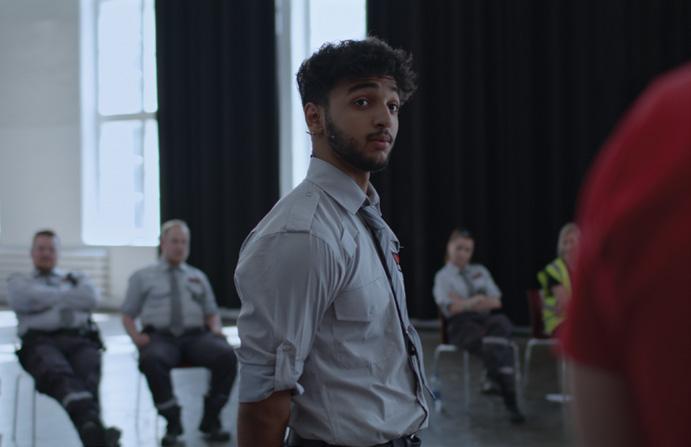

11
Pilvi Takala, film still, Close Watch, 2022, 1:08:13, three-channel video installation. Image credit: Pilvi Takala
Pilvi Takala, film still, The Trainee, 2008, part of an installation with three videos, PowerPoint, keycard, and letter.

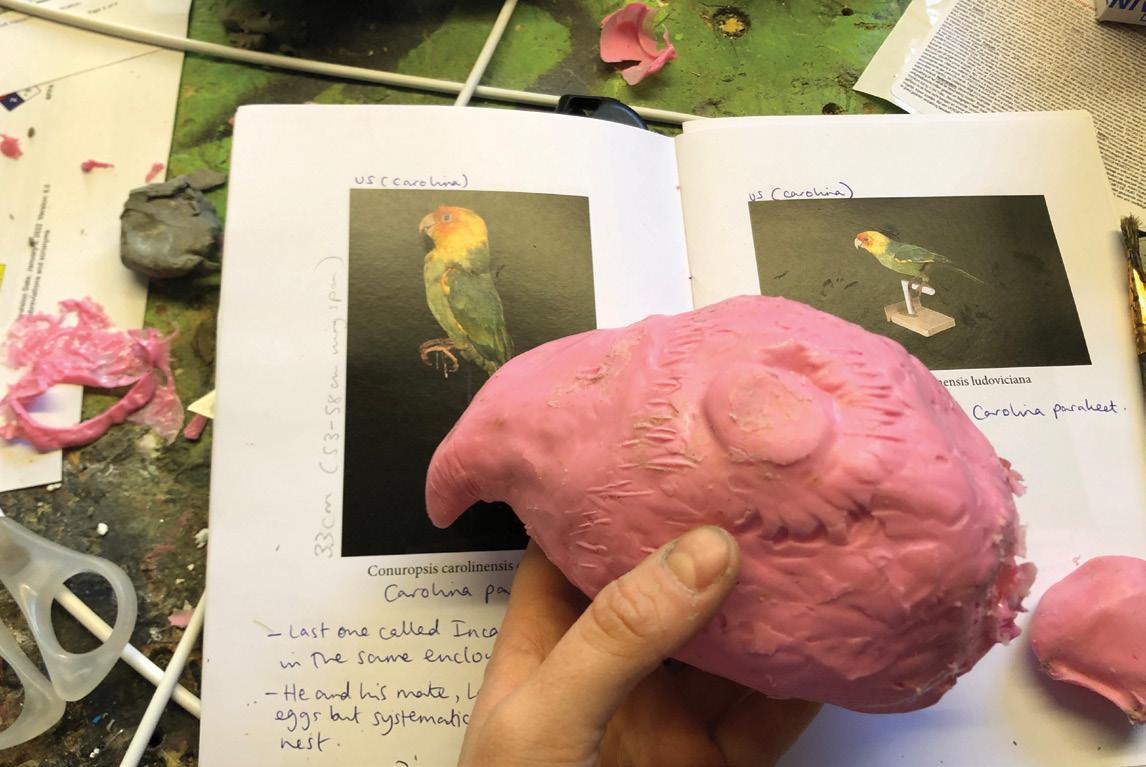
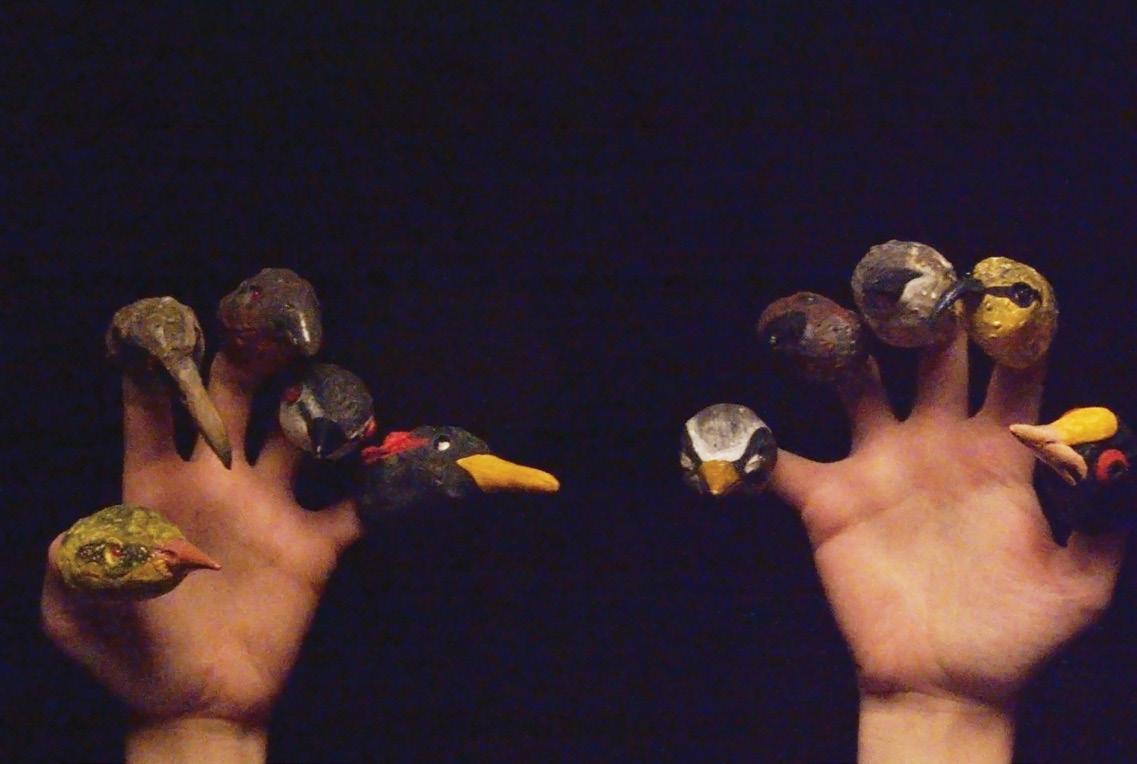
12
–
↑ A puppet Norfolk Kaka encounters a human dressed as her. Still from Cloudcuckooland (2024) by Georgie Brinkman.
Making a Carolina Parakeet puppet in Kooman’s Poppentheater workshop, The Hague.
↓ A selection of clay finger puppets. Still from Cloudcuckooland (2024) by Georgie Brinkman.
‘We are Sky-Breakers’
‘We are Sky-Breakers’ is an artistic research project that employs puppetry to think about extinction, disruptive imagination, afterlives, and tricks of the eye and the mind.
Its starting point is a special collection of 62 taxidermied, extinct birds at Naturalis Biodiversity Center, Leiden. Over the last few years, I have been making puppets of these birds as a reparative gesture, hoping to imbue them with renewed life. These puppets — and the lost birds they represent — are characters in short film experiments. Puppets, as the visual representation of trickery, tangibly reveal human control. But they also offer a form of childlike (re)enchantment, seducing the viewer into a suspension of disbelief about their perceptions of what is real or alive. What does it mean to attempt to give back life to those we took it from?
Alongside learning puppet-making, the project has given me the opportunity to research the extinction stories of these birds. I have encountered small penguins beaten to death for fear of being witches, parrots’ nests trampled by the hooves of cows and enormous cormorants eaten by sailors. There is even one small bird from Borneo who escapes the clutches of extinction and reappears after almost 200 years since being last seen. Collectively, they form a microcosm of our global socio-political condition. All of the birds have, in some way, been driven to extinction through the same capitalist, patriarchal or colonial endeavours that have led to the current climate catastrophe and habitat-loss. These include: damaging agricultural practices, the introduction of invasive species, and hunting.
Guided by Saidiya Hartman’s principle of ‘critical fabulation’ and looking back to the disruptive force of the mythological Trickster figure, I have been thinking of ways that these stories can be rewritten, acting as a refusal of extinction and rejection of violence.
I set out at the beginning of this Research Group with the question ‘how can a contemporary revival of the mythological Trickster figure help to tell stories of extinction that reconfigure perceptions of time?’ I have begun to realise that the Trickster figure is not only a player within the narrative, but is the form and flesh of the narrative itself. How can the Trickster be revived not as a character, but as language and image? How can we embody Tricky thinking and ways of being to reckon with a phenomenon of mythological proportions — the extinction of a whole way of life? These questions have led me to a new area of research — the Tricky linguistic world of riddles.
Key Terms
13
Trickster Puppetry Critical fabulation Biodiversity loss Talking animals Re-animation Storytelling Crafting Afterlife
Extinction
DEEP FUTURES RESEARCH GROUP 2023 – 24 RESEARCH PROJECT
The greatest riddle is sung in flesh. How can a thing be yet not exist? How can a thing exist yet not be? We, the chorus. The dawn chorus. A chorus of birds. Chorus of creation in a dead bird’s skin. Creation sings in the bird’s dead skin. Bound in another, all things begin. This riddle ponder o’ children of earth! Eagerly seek to trace our trails.
We are sky-breakers.
Can you guess my name? Or mine? Do you know my voice? Say who we are! Say what we mean! It would take too long to tell our fate through the world’s web. That would be a wonder of speaking. Sometimes we must sing through the throat of a friend. Untwist your mind and sing creation with us.
Riddles are a new area of research that developed during my time in the Research Group. The above text is the opening dialogue from my compilation of film experiments, Cloudcuckooland (2024). It is composed of extracts from riddles and analytic text in Craig Williamson’s A Feast of Creatures; AngloSaxon Riddle-Songs, and is spoken by clay finger puppets representing each of the 62 birds from Naturalis’ extinct bird collection.
For a while, I have sensed a natural connection between riddles, Tricksters and puppetry, and the Research Group gave me the opportunity to dig deeper into this. Riddles, like puppetry, demand dialogue with the audience. Just as the puppet breaks the fourth wall of the theatre stage to converse with its audience of shrieking children, the riddle speaks directly out of the page to the reader: ‘Say what I am! Say what I mean! This riddle ponder!’ it commands. Riddlic language is inherently about trickery. It is meant to deceive. But, more than this, a riddle’s tricky linguistic games ultimately have the purpose of teasing you into reimagining familiar objects, animals or even concepts. As such, I see riddle-solving and riddle-writing as forms of disruptive imagination. Riddles use language as world-making. Across global mythologies, one of Trickster’s inherent qualities is being at the borders of language and active in the art of lying. Lewis Hyde claims that ‘it is trickster who invents the gratuitous untruth’.1 It seems natural that Trickster’s mother tongue would be riddles. In 2023, I was invited to give a talk and workshop for OtherWise, a foundation exploring creative methods toward environmental and social justice at Wageningen University. I decided to experiment with a riddle-writing exercise about the birds. At the basic level, I wanted my participants to have the sensation of tricking someone. At a more fundamental level, I wanted their riddles to reveal a new perspective on the birds. To set up the exercise, I positioned all of the 62 clay finger puppets on a table. Each had a number assigned, and next to them lay a small card with a photograph of the original taxidermied bird, its name and some snippets of information about them. Participants paired up, were given a random number corresponding to a bird and had to use the information presented on the card to write a riddle. We then reconvened as a group to guess one another’s riddles by selecting a finger puppet from the table and placing it upon a finger. Ten guesses and you’re out. I was pleasantly surprised that, in all but one case, it was possible to deduce which bird the riddle spoke of.
14 RESEARCH NOTES
I wrote a riddle too. It was more challenging than I anticipated to write in a manner that was purposely deceptive but left small clues for the reader. I was also surprised by the openness it gave me to approach these birds in a totally different way. I felt I got to know these birds better, think about them more actively, deeply and obliquely. The act of writing a riddle about the bird felt almost like writing to protect them. To conceal them in Tricky language so that they became hard to find. It helped me to form a different register of emotional connection. Throughout this project, I have struggled with finding ways to tell stories about the birds which do justice to their real, lived histories. I have felt tied to a realistic representation of their extinction stories, which has constrained me. But the freedom of depicting through riddle allowed me to escape this.
The next stage in my research is to experiment with ways riddles can feed into my aesthetic decision-making in telling the stories of these birds. For example, I have extracted quotes and images from riddles to act as prompts for filmmaking. Just as I have realised that the Trickster figure is not only a player within the narrative, but the form and flesh of the narrative itself, I realise that the riddle is not just language, but a way of thinking. Particularly, Tricky thinking.
1 Lewis Hyde, Trickster Makes This World; How Disruptive Imagination Creates Culture (Edinburgh: Canongate Books, 2017), 45.
Georgie Brinkman
MA Artistic Research coordinator
Georgie Brinkman is an artist, researcher, filmmaker, and fan of talking animals. Through artistic research, her work treads a precarious ground between science-fiction and science-fact. She uses art-making to feel and think about what it means to be human in a time of ecological collapse and mass extinction. Or, importantly, what it means not to be human? What does it mean not to be alive?
She tells stories about multispecies worlds, casting beyond-human animals and beings as leading protagonists. In Georgie’s constructed worlds you may encounter a suicidal parakeet, a leech who is a poet, or an ocean with a broken heart.
Georgie’s work has been supported by Leverhulme Trust, Arts Council England, European Cultural Foundation and Gemeente Den Haag and has been developed and exhibited at Stedelijk Museum Breda, Kooman’s Poppentheater, Media Art Friesland, AADK, Het Nieuwe Instituut, Page Not Found, iii, SEA Foundation, Art au Centre Liège and More than Ponies.
At KABK, Georgie is coordinator of Lectorate FILM and MA Artistic Research (from which she graduated in 2021).
15
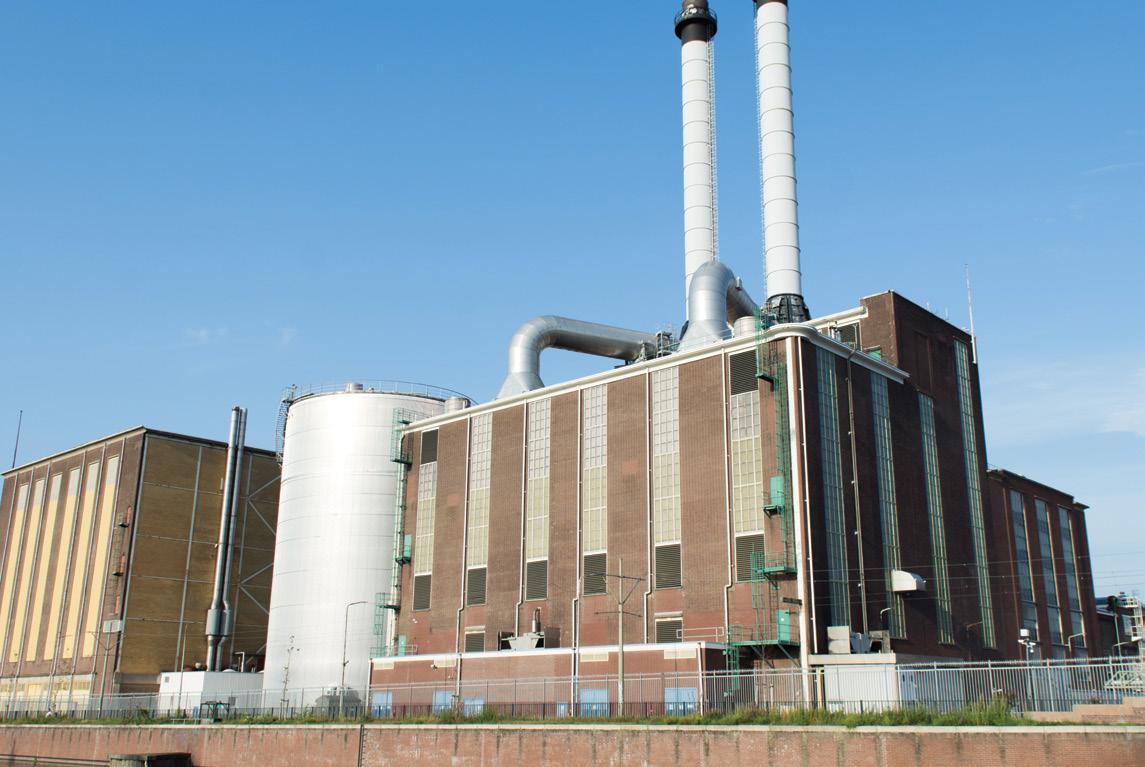

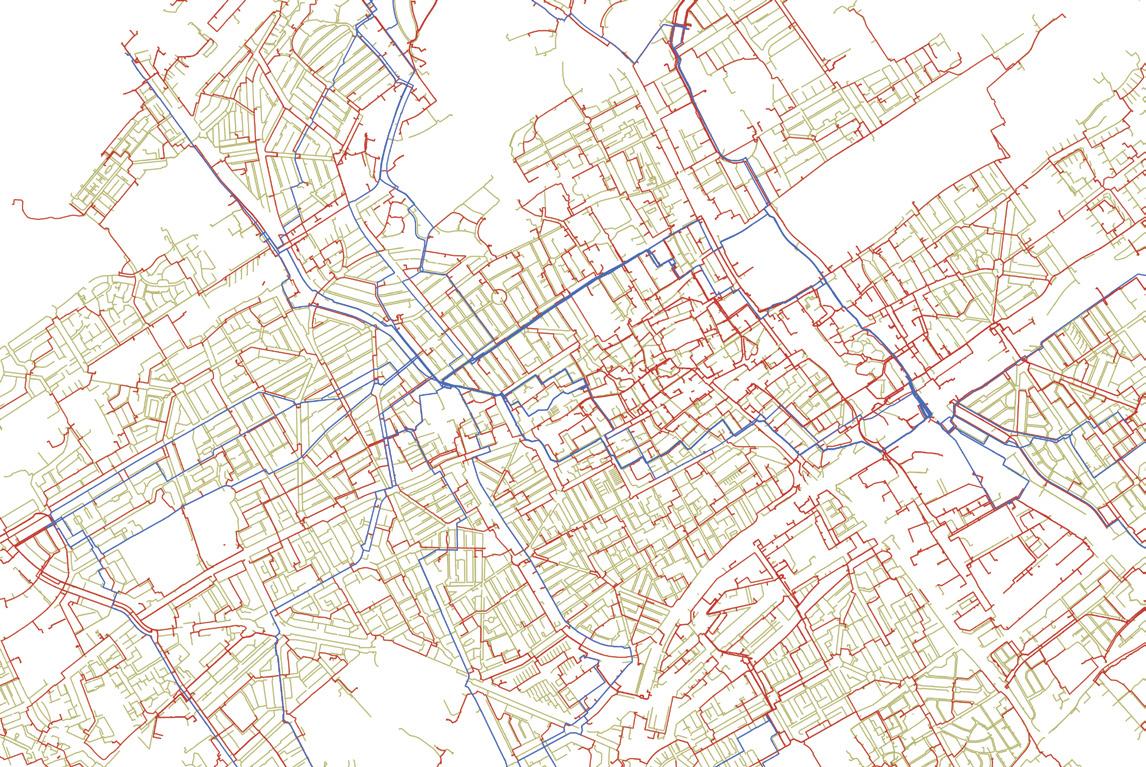
↑ The Hague City power plant. Image credit: Boudewijn Buitenhek.
Electricity power cables exposed, The Hague. Image credit: Boudewijn Buitenhek.
↓ Map of energy grid, The Hague.
16
–
‘Following the Path of Electrons: Energy Use in Artistic Practice’
Electricity is an invisible resource. From its generation in distant power plants to its underground transportation to our homes, and the concealed network of wires within our walls, for many of us, especially in the Netherlands, our connection to this resource has become increasingly abstract. How can we redesign or adapt our environment to make the concept of electricity more tangible and integrated into our lives, guiding us to make more conscious decisions about its use? How can we reorganise our daily routines, adjust our behaviours, and align our schedules with the available energy in our surroundings?
In my previous work I have explored the role of energy inside my own apartment, including designing a coffee-making tool to harvest solar energy. This tool enabled me to explore energy independence; I learned how to adjust my routine to fit around the moments when sunlight was available and to acknowledge the limitations I faced when adapting to this alternative lifestyle. During my time together with the Research Group I have extended this research outside the confines of my apartment to explore energy consumption in relation to processes of making inside the art school, my place of work.
17 Key Terms Energy systems Hidden networks Electricity Transduction Transmission Transformers Electrical grid Mapping Measuring Powerplants
DEEP FUTURES RESEARCH GROUP 2023 – 24 RESEARCH PROJECT
13 October 2023
Hi Deep Futures team,
I look forward to kicking off the individual hosting sessions with you this Friday. We will meet at 10:00 at Constant Rebequeplein 20 in The Hague. The location is easily accessible by taking tram 3 from The Hague Central station. From there we will start the day by taking a walk around the city power plant to experience the building and the surrounding environment.
We will walk back to KABK following the hidden network of underground highvoltage cables. This will be a 35-minute walk so make sure to put on some comfortable shoes if anyone is physically unable to walk back to KABK feel free to use alternative transport).
The rest of the morning we will read and discuss the texts I have selected, including:
Loove Broms, Cecilia Katzeff, Magnus Bang, Asa Nyblom, ‘Coffeemaker Patterns and the Design of Energy Feedback Artefacts’, Proceedings of the Conference on Designing Interactive Systems, Aarhus, Denmark, August 16-20, 2010.
Afterwards, we can go into the 3D Lab for some hands-on experiments with tools to measure energy use and to test and compare energy-saving methods in 3D printing.
In my workshop, we have a lot of control over the energy consumption of our machines. Print speed, layer height, and material use all impact the amount of kWh used during the process. In the software we use to prepare print files, a very fine layer height is now described as the ‘quality’ option. However, this wording might be a bit deceiving, as the difference between a 0.10mm layer height and a 0.20mm layer height is often indistinguishable to students, while the print process can take twice as long, and consume twice as much energy. Selecting materials that don’t require the use of a heated bed can also make a big difference. I’ll be showing examples of these differences during our meeting. Another more radical intervention is that we could pause and resume the print process during hours of high energy availability using the built-in power loss recovery functionality in our 3D printers. I’ve already started experimenting with this idea in my solar-powered 3D printer tests.
The 3D lab will be the starting point for my energy research within artistic practice, but my goal is to reach out to other workshops to explore the role of energy in their particular specialisms.
If there has been enough sun the previous day, we will make tea with water heated by my solar-charged battery.
See you Friday!
Boudewijn
18 RESEARCH NOTES
A note: The Hague city power plant is currently operated by a company called Uniper, which owns and operates three more power plants throughout the Netherlands. The area of The Hague where it is located is called ‘Energiekwartier’ and is populated with studio spaces for artists and designers, embodying that cliched and forced connection between the industrial production of energy and the production of creatively energised ideas. The language of the ‘danger high voltage’ and necessary safety precautions signs conflicts with the attempts to gentrify the area. I’m starting to understand how this area does not give off the most relaxing energy. I’m intrigued by these contradictions, which might play a role in my research as well
Boudewijn Buitenhek
3D Print Lab instructor
Boudewijn Buitenhek is a speculative product designer-researcher and is part of the team of workshop instructors in the KABK 3D Printing Lab. Boudewijn has a BA in Industrial Product Design from the The Hague University of Applied Sciences (THUAS) and an MA in Industrial Design from KABK. His work has been exhibited in Het Nieuwe Instituut, Dutch Design Week, and during the 2022 Solar Biennale in Rotterdam. His current research work is focused on renewable energy sources and patterns of energy consumption. By developing tools and hacking the home environment, Boudewijn explores how more embodied engagements with energy might help reconfigure deeply rooted habits around the energy that powers our lives.
19
↓
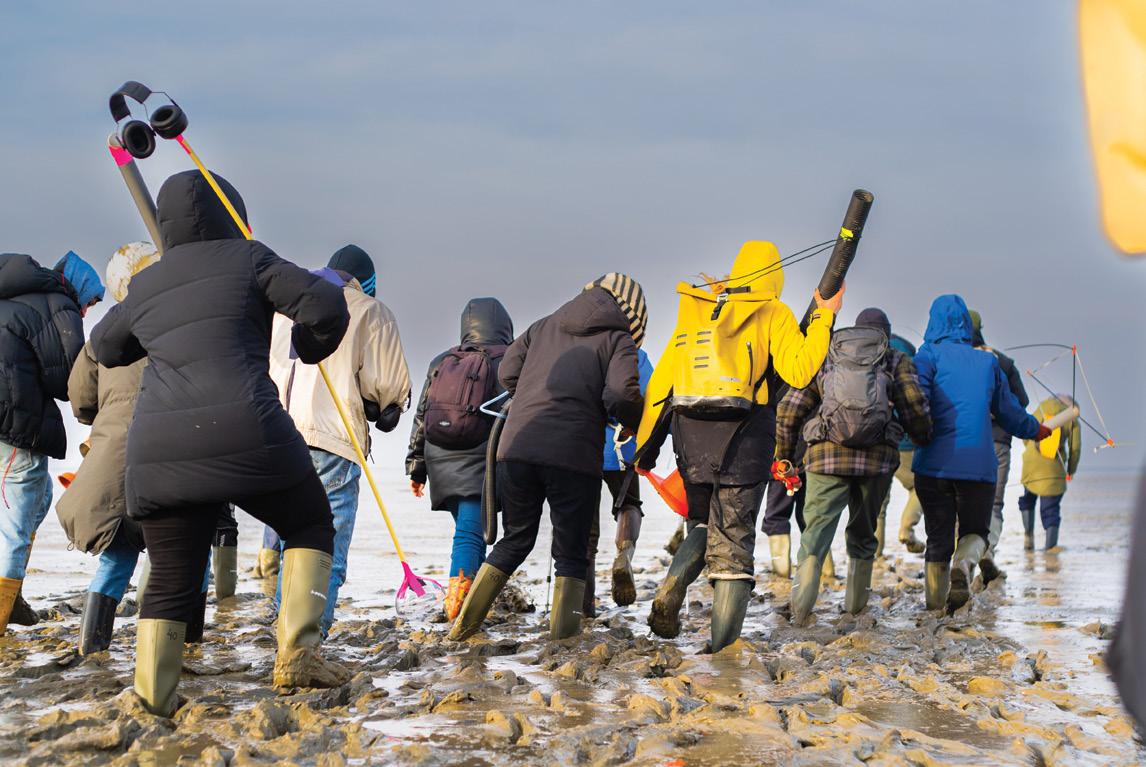


20
↑ Cocky Eek, The Muddy Muddy Mystery Tour at Moddergat, 10 March 2024. Image credit: Bora Sekerci.
–
Resetting the Clock to the Babylonian Time-zone, notation of a dream, 12 Jan 2024. Image credit: Cocky Eek.
Students on the edge of the Dobbe in the Salt Marshes, view from the tower at Het Lage Noorden, 8 March 2024. Image credit: Cocky Eek
‘Dark Skies and the Art of Dreaming’
The Wadden Sea, as one of the largest tidal planes on the planet, ties together sky and mud. At night, this is the darkest area of the Netherlands, with relatively little light pollution. It is a place still governed deeply by cycles of the moon and other celestial bodies. Their force of influence extends also into our imagination and culture. What can the dark sky tell us if we listen to the depths of its mysteries?
This research is strongly anchored in place. Place can extend to the outer realms of the cosmos. Exploring the depths of our experience while being in one place. Extending even into our dreams.
Together with twelve ArtScience students I conducted improvisational research under the night skies of the salt marshes of the Wadden Sea during the darkest week of November 2023. This is not research done alone, but involves local people, local beings, as well as the darkness of the sky and the pitch black mud below our feet. As a collective, we shared our experiential findings with local residents in synchronicity with the falling stars of the Leoniden swarms. What a night! And I wonder: what happens if, in our educational systems, we would tune in more with celestial rhythms?
21
Terms Dark skies Locality Black holes White holes Sensation Imagination Salt marshes Cyclical rhythms Tuning Dreaming
Key
DEEP FUTURES RESEARCH GROUP 2023 – 24 RESEARCH PROJECT
10 November 2023, Zeedijk, Marrum, 53°19'59.2"N 5°46'38.9"E
It was dark and cloudy, and there was not a single star to observe in the sky. What is a good place to take a walk here? I asked Stephan: Ohh, just over the dyke towards the east is a nice walk, he said. And off we went. The dark skies I imagined as my research subject were not that dark at all! Light from the harbour of Holwert 10 km further along the coastline was shining loud and clear with dozens of bright lights visible. Looking to the south, two villages in the neighbourhood were also clearly signalling their presence. I was beginning to lose courage until we stopped and I saw belit was silently facing the swampy area that extends beyond the dyke into the Wadden Sea. We joined belit and all stared into that darkness. For a while we hesitated, because it seemed so inaccessible, until the moment we could not hold ourselves any longer: Lets just go in there! Ohh, but what about your nice sneakers? I asked Boudewijn. I don’t care about my sneakers, he said, I just need to go there!
We ignored the signs saying ‘forbidden to enter after sunset’. We could not see a thing but, by touch and our inner sense of direction, we found a dobbe: a circular hole in the salty marshes, filled with fresh water. Standing on her clay wall, facing the pool, silenced us. Marlot discovered sounds coming from below: we lowered our ears close to the ground and listened to the little sizzling, bubbling and squeaking sounds responding to her footsteps with a delay. Swinging, swaying, giggling and with a thousand ideas bubbling up, we hopped back to our headquarters.
13 November 2023, Salt Marshes, Marrum 53°19'59.2"N 5°46'38.9'E
If you leave now you will be back right in time before the high tide comes in, and lunch will be ready. Do you have your phone with you? asked Stephan before we left on our first morning. We walked the same terrain as I had with the research group the week before, only now, I was with my students. We went much further into the salt marshes, attracted by the body of the sea. While going further the mud became increasingly prominent. Surprisingly pitch-black ink came from under our footsteps. With each step it became more tricky to pull our boots out of the mud; you had to invent a certain walking technique, improvised along the way, so as to not lose your boots. I stopped for a moment to look over my shoulder. How is the rest of the group doing? But stopping meant I immediately sank in the mud and was stuck. I needed the others to help me out. Eventually we were able to move on till we reached the edge. Here we stood, absorbed in the moment, staring at the horizon, where water and sky merged. The tide was coming in, filling the little veins of the salt marshes. Even though we were exploring the rhythms of the celestial bodies above, mud proved to be a key material to anchor us in the research.
22 RESEARCH NOTES
10 March 2024, Salt Marshes, Moddergat-Paezens 53°19'25.6"N 5°44'15.28"E
Harry, our mud tour guide, told me that we could only do this walk 25 km north in Moddergat (Mudhole). The sky was grey that morning. It rained, it was chilly and the wind was strong: for a moment I thought whoee, such rough weather for a long mud tour! Around noon — just before the group of 30 workshop participants arrived, the sky cleared. To prepare for the walk I asked people to work in duos or trios to make DIY mud-sensing devices. Carrying a weird array of tubes, sticks, and other contraptions, we climbed over the dyke and stepped straight into the vast mud planes extending to the horizon. Already, with the first steps, some peoples’ boots started to fill with muddy water. Many sensory devices collapsed instantly, revealing unexpected new ways of using them, some flew away, and some people fell over. Others, equipped with expensive cameras, did their utter best to keep up straight in the slippery deep mud. We kept on walking. With all the devices, some flapping like strange flags, we formed a long procession (stoet). I had to be extremely centred in myself, to counter the forceful wind in this vast open landscape. While we kept on moving I noticed the strange tendency of certain bodies in the group being attracted to one another. Certain characters kept converging, as if automatically attracted to each other. This phenomenon came back in my research. But the biggest attractor in all these group journeys was the dark mud of the Wadden Sea, like an organic black hole, mirroring the darkness of the Friesian nightskies. A darkness that can unite groups and minds, attracting them together.
Cocky Eek
ArtScience tutor
Cocky Eek has a well-established experimental field and spatial practice encompassing monumental inflatables and lightweight immersive installations. By staging tangible interventions in very particular sites, she aims to expand our power of perception in direct relation to the senses and the environment. Her experiments allow people to experience moving, flying or floating, but rather than the sensation of moving through space, we feel that space is moving through us. Her work connects with the deeper layers of ourselves and of our surroundings.
Cocky has been a core-team teacher in the ArtScience Interfaculty at KABK and the Royal Conservatoire in The Hague since 2009 and is a member of the KABK Deep Futures Research Group 2023 – 24, where she explores the voice of darkness from the mudflats of the Netherlands. Between 2018 – 2023, Cocky led artistic field research programs at the Field Academy at StrandLAB Almere. Recent presentations and exhibitions of her work include: Landscape of Care, Tiznit Morocco (2019); Spectrum, Spring Festival, Utrecht (2020); Amstelpark as Sensorial Heritage–field program, Zone2Source, Amsterdam (2022); Resonant Bodies, 23rd Biennale Sydney (2022); The Muddy Muddy Mystery Tour, Sonic Acts Biennial, Amsterdam (2024); UMAA-Unité Mobile d’Action Artistique, Mille Plateaux, Centre Chorégraphique National (2024).
23



↑ Listening to our sounding bodies during ‘Sonic Sources’, broadcast by Deep Futures Research Group for Mushroom Radio, 27 October 2023. Image credit: Alex Schröder.
How a body can be translated into symbols or signals, 2024. Image credit: Marlot Meyer.
↓ Generating feedback loops of signals between a body and simple neural network, 2024. Image credit: Marlot Meyer.
24
–
‘Sensitive Systems’
‘Sensitive Systems’ is a research project that explores alternative methods for sensing, processing, and translating meaningful physical interactions. This focus came after a firsthand experience of the fundamental mismatch between data-driven systems and the world they interact with: I had created and exhibited an interactive system that used technology to facilitate a non-verbal form of communication between visitors. Over time the system had learned to give the highest intensity of electrical stimulation to visitors, since this resulted in the most predictable response of visitors’ biodata in return (pain and shock). How, I wondered, could I create a system that wouldn’t just base its learning on highest rewards and optimisation of prediction? Or, how could I define the rewards to include situated meanings and experience?
The living, breathing world is intrinsically and inescapably interconnected and entangled, and nothing can be fully understood or represented in isolation. This, however, does not mean that we need more expensive scientific tools or specialised technologies to create larger datasets or more complex models. Data is a reductive representation of the world. When meaning is derived from data processes, it will always overvalue things that are measurable and definable, and inadvertently erase things that are not. In the age of algorithmic information and generation, knowledge-making about the world through intuition, embodied experience, and relational understanding are becoming harder to focus on. But must we write off technology, and artificial intelligence or machine learning as incapable of doing it differently? Can a technological system, that works by collecting values from the world, be able to do so without detaching or extracting those values from their ‘live’ entanglement? Can such a system learn from, communicate to/about, and care for meanings that are not measurable, definable or separate-able?
To answer these questions I employ qualitative approaches1 to working with signals which emphasise embodied, situated observation and experience as a way to understand complex systems.2 Currently I am observing, listening, creating and experiencing feedback loops to find relationships where both human and system can learn to attend to the rhythms of the bodies, cycles, and interactions that they inhabit and are embedded in.
1 Debra Solomon, ‘Radical Observation: A series of awareness exercises for developing inter-relationalities with natural world ecosystems’, Journal of Delta Urbanism, no. 4 (2023): 88-101.
2 Robert E. Shaw, Endre Kadar, Mikyoung Sim, and Daniel W. Repperger, ‘The Intentional Spring: A Strategy for Modeling Systems That Learn to Perform Intentional Acts’, Journal of Motor Behavior 24, no.1, (1992): 3-28.
25
Mapping Communicating Input / Output System Data Sensor / Sensing Embodied / Embedded Symbol / Signal Feedback Loop Sensitivity
Key Terms
DEEP FUTURES RESEARCH GROUP 2023 – 24 RESEARCH PROJECT
Sauna, 8 December 2023
Today I hosted my fellow researchers at the site of my research. Since bodies and their experiences are the site and source of my research, hosting so many eager and invested bodies together at my studio was a meaningful moment. I had just begun mapping raw, unfiltered biosignals to sound signals and although I had listened for a while to those sounds coming from my body, I could never really make anything more of it because I had no other body to relate it to. I was trying my best to avoid any kind of cognitive or computational comparisons when listening or working with the signals — but mapping the signals from different bodies to sounds could become a tool of relating to each other and ourselves, without the quantification or categorisation.
Speaking of relating — I was anxious that we wouldn’t. There are several reasons for this, the origin of them being the remarkable contrast between the well-defined, easily reproducible methods and outcomes of academic research, or theoretical frameworks which can be understood through thinking and reading, versus the intuitive, situated, serendipitous methods and outcomes of an artistic process, which very often consist of moments that escape our language and ways of measurement. These moments of magic feed everything I do. I worried that forcing the magic into a box of methods and outcomes could make it disappear.
On grey dark days in the deepness of winter, our bodies are wrapped in layers to keep out the cold and rain. Unfortunately for me, this also unintentionally keeps in some relating-ness to others, and makes it harder for the ‘magic’ to happen. To combat this I had devised a plan that began with listening to our sounding bodies — first individually, then together, followed by a ‘gossip session’ in the sauna that belongs to my studio complex.
There’s that feeling we all know when you become engulfed in warmth — all your muscles relax, every skin cell expands to allow for maximum exchange between the inside and outside: your pores open as your skin’s sweat glands start secreting that salty fluid. Sweat.
What I really want, and what I actually meant to do with this research was never focused on the system or technology in and of itself.
It was always about helping people become more aware of, and in tune with, their bodies. But the systems and tech we use right now is the biggest reason we are lacking this sensibility. I think that it can either numb the signals, or it can help us to learn how to listen to them again.
Our egos and their individualisms, insecurities and opinionated identities don’t last long in temperatures this high. As we sweated and shared our meanings, passions, purposes … there it was.. The **magic** moment...
There was something about being inside the sauna together — when we lost our egos and stripped our ‘selves’ to the essence of the present experience — that completely penetrated through every body. How, then, can I re-create this sauna feeling — these sauna conditions — so I can teach systems about it, as I go forward with my research?
26 RESEARCH NOTES
Marlot Meyer
BA Interactive Media Design tutor
Marlot Meyer was born and raised in Cape Town, South Africa, and lives and works in The Hague. Since graduating from the Interactive Media Design (IMD) department in 2020, her practice has explored how to redefine the ‘body’ beyond the human body ending at the skin, to include the online, ecological, electric, and collective, shared body.
Embracing the DIY mindset, her practice is driven by an intuitive curiosity for how systems work. She uses technology as a tool to infiltrate, examine, and reconstruct the often unseen energies inside and between bodies. As a maker and teacher, her intention is to provide an embodied form of learning for her audience. This intention extends to her role as a tutor at KABK, where she leads the ‘IMD Studio’ course for 3rd year IMD students, guiding them through their self-directed projects that involve personal, conceptual, theoretical, and material research.
Working with the body as a source of information and material, she explores what embedded knowledge lies within our physical bodies, and how we have created cultures, practices, and tools around it. She collaborates with researchers and scientists to understand the biological body, exploring alternative practices of harnessing and creating embodied knowledge.
In 2022 she was the recipient of the ‘Bio Art and Design Award’, together with neuroscientist Marcel de Jeu, for their project ‘Hacking Heuristics’. Her work is frequently exhibited in the Netherlands and internationally, including Ars Electronica (2023) and Meta.Morf: Trondheim Biennale for Art and Technology (2024).
27

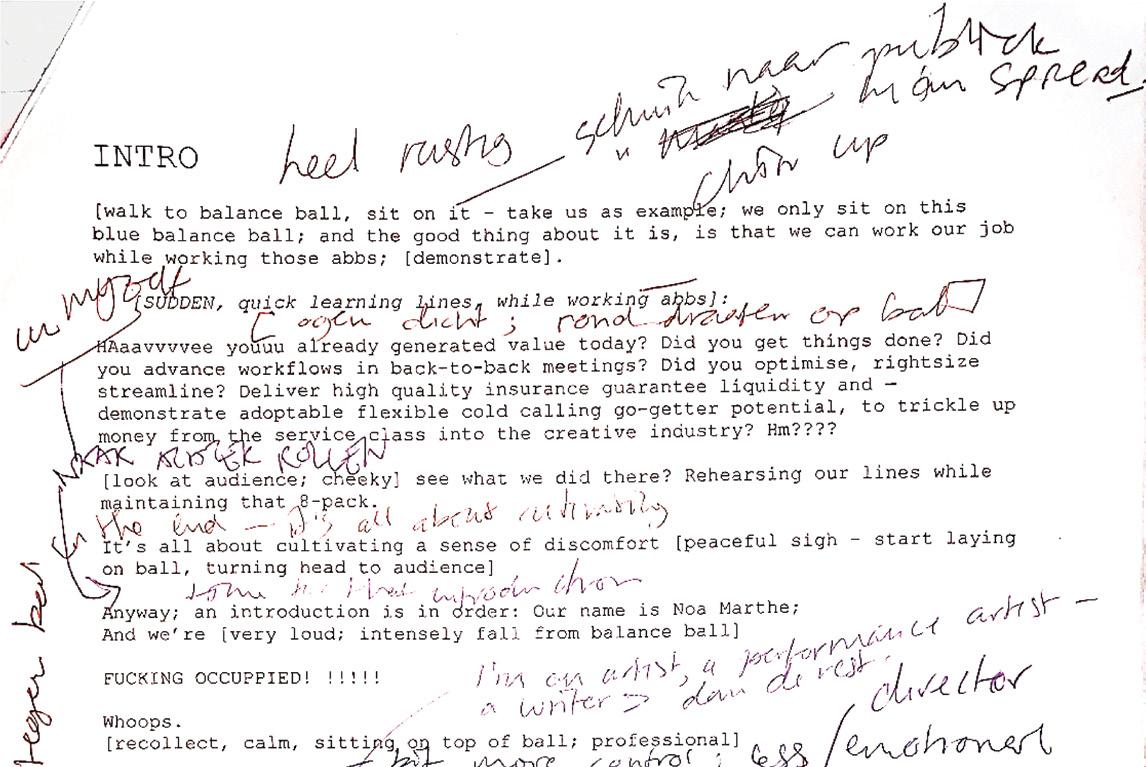

↑ Noa Martha Prins, film still, Noa Marthe rehearses refusal during a tutor meeting in the Gipsenzaal KABK The Hague, enacted by members of the Deep Futures Research Group, 2024. Cinematography: Rik Kómaromi.
– Noa Marthe Prins, script excerpt, ‘If Not a Worker, Who am I?’, 2024. The constant moving back and forth between speaking out written lines and annotating; altering; re-scripting. Image credit: Noa Marthe Prins.
↓ Noa Marthe Prins, Deep Futures Research Group members discuss staging refusal with cinematographer Rik Komaromi, Gipzenzaal KABK, 2024.
28
‘If Not a Worker, Who Am I?’
With ‘If Not a Worker, Who am I’, I deploy and develop theatric strategies to rehearse understanding, resisting and refusing the exploitative and destructive forces of work.
From our social relations; the workouts we perform between sidehustles; overnight oats and meal preps; sleep-rhythms; forming households and families; all these activities seem to have been co-opted by a grind-culture logic obsessed with work; obsessed with productivity. What do we value as productive? As time well spent? And shouldn’t we ask: what is the cost of work? Do what you love, they say, and you will never work a day in your life.
Over the last years we see a discourse emerging that problematizes work. The anti-work movement, the Great Resignation, and the ‘quiet quitting’ movement all in their own way argue that perhaps the most pressing task in fighting planetary exhaustion and destruction, is to radically rethink the most normalised of ideologies under neoliberal capitalism, namely the totalisation of work and our constant drive towards productivity. Within this discourse, arguments are made for understanding ‘work’ not as a site of value production, but rather as the site of destruction. Emancipation and liberation happens not through, but away from, wage-labour. Echoing Silvia Federici’s ‘Wages Against Housework’, waging ‘social reproductive’ work — mystified by capitalist rationalisation as an innate feminine quality — for instance, will make its refusal possible through visibility on the one hand, but may also lead to the redistribution of exploitation to a new oppressed class on the other.
Not so long ago, my own act of refusing work led me to write my first theatre performance titled ‘Curriculum Veto’. It questioned the many types of ‘wasted’ work, that fall between the lines of the Curriculum Vitae, or ‘the Course of Life’. My activist-; refusalist-; care-; love-labours on the one hand and the countless ‘real’ service-industry side hustles on the other. So much for the myth of meritocracy!
Within the Deep Futures Research Group I set out to strengthen the theoretical and methodological foundations of my performative experiments for rehearsing refusal. To inform script-writing, I distil language from sites of exploitative productivity. I study gestures of optimised performance, exploring the extractive limits of the body as a site that can be mined for energy; that can be sourced, exhausted, self-optimised, made hyper-flexible, hyper-focussed, mind-ful, and burned-out. And, I conduct experiments that stage — often feminised — ‘unproductive’ forces such as idleness; hysteria; wasting time; exhaustion and madness as proposals for resistance, or as rehearsals of refusal.
Key Terms Exploitative
AgitProp Women’s work
Script writing (Rehearsing) refusal
29
productivity Anti-work Exhaustion Performance
Embodiment / Movement
Satire
DEEP FUTURES RESEARCH GROUP 2023 – 24 RESEARCH PROJECT
Every miscarriage is a work accident.
[...]
More smiles? More money. Nothing will be so powerful in destroying the healing virtues of a smile.
Neuroses, suicides, desexualization: occupational diseases of the housewife.
—Silvia Federici, ‘Wages Against Housework’, 1974
No more ghoulish euphemisms. No more verbally sanitised hellscapes. No more warmongering lies.
—Anne Boyer, Excerpt, resignation letter as poetry editor of The New York Times Magazine, Nov 13 2023.
March 8 2024, Museum de Lakenhal, Leiden, 21:30
It’s International Women’s Day and I take in the people forming rows of audience, neatly seated, facing me. Familiarising myself helps with the fear, I learned.
I wave the technician Lars to the front and ask him to wire me up. Lars is tall, Dutch-looking. He studied Fine Arts and works full time as museum-technician. Rather than doing it offstage, I asked him to engage in the clumsy business of providing me with a headset microphone on stage. Wanting to waste time. While I pull back my hair Lars carefully puts the headset over my ears. I turn my head towards the people; decide to take away their confused looks, their worried eyes and comfort them. ‘Just give us a moment’, I say, ‘to test this—’ Lars pulls the wire from under my shirt. Even though we rehearsed it several times, he’s a bit nervous I notice. ‘Okay! The mike is on, there you go’, he says. And walks away.
‘Every miscarage is a FUCKING workproblem!!!!!’ I shout hysterically. Silence. ‘Yep, that works’. I look at the audience and smile exhaustively. It’s the type of slavering smile that says ‘I am happy to serve’.
Meeting Minutes, 7 Nov 2023, 14:00 - 17:00 (excerpt)
Yeah Yeah. Internal mobility. True. It’s very important, from now on. I know... there is a core-team, and a larger body of more flexible ‘onion-workers’. They’re like the skin of an onion, peelable, you see? Protecting but not — never! — suffocating the core-workers. We wouldn’t want that now would we. This way the department will stay fresh. Sharp. Onion rings = On top of things.
A lot to discuss today. Such as budget cuts — point one on the agenda. Nobody really understands them! The budget cuts. Like. where they come from. Why they are needed and/or where the cutting will take place. But we’ll get to that. no worries. We are in this together. First the Agenda. You open Teams… O before I forget! Is anyone — has anyone something urgent to share? Yeah, about contracts vs freelance, I… No? Ok great so where were we? Yes. Open Teams, go to Teams, Graphic Design, Now Click, Files. NO! Not Files; First, Tutors General Channel. Now on top you see ‘Posts’ and ‘Files’. Do we all see this? Yes? Now click ‘Files’! Yes. You see HR incidental tasks, Schedules, Tutor meetings.
30 RESEARCH NOTES
Click Tutor meetings. Inside, on the top you find: ‘GD_Tutor Meeting’. Click Open! Everyone with me? Great. So. On the agenda today: Budget Cuts, Rock vs River system, Diversity and gender-diverse pie charts . . .
March 8 2023, KABK, Rehearsing /staging refusal
Rik Komaromi follows Boudewijn with his camera. Boudewijn plays core-tutor /manager and folds a paper plane from a flip-over-sheet quantifying genderpercentages of department staff with the use of pie-charts. ‘15% gender’ it reads. He throws the paper plane through the Gipzenzaal, the art academy’s extravagant boardroom. It soars over my head and hits Marlot. ‘Nice’, he says.
Between three lethargic-looking plaster busts, a giant decapitated foot, scattered residue of lunch, papers, laptops, my body lies outstretched on the room’s meeting table. I cry a little, or laugh, I’m not sure. Rik, meandering virtuously between and around our acting bodies, now puts his camera on Marlot. She does not seem to notice and tries to convince her co-workers that borrowing metaphors from nature to describe complex bureaucratic systems is dangerous.
Alice doesn’t listen. Why would she care? She takes a sip from a bottle. ‘This is food’, the label claims. Alice gets up, walks to the whiteboard and writes: ‘No No No No No No No more verbal sanitation; No 0.000000173 FTE; Where is the I in Teams?; Excel does not Exel!’
Georgie gazes dead-eyed into the replica of the Ports of Paradise that rises high behind the room’s oval table. Resting her feet on top.
‘History is full of people who just didn’t’, I think. Nos and won’ts can serve as an existential mode of resistance against the capitalist yes.
Noa-Marthe Prins
BA Graphic Design tutor
Noa Marthe Prins is a performance artist and writer based in Amsterdam. Drawing from tactics of resistance theatre and comedy, she explores the relations between exploitative productivity and the performativity of work. Proposing a radical rethinking of the totalisation of work under neoliberal capitalism, her performances and installations address issues such as: the false promise of labour-saving technologies; women’s bodies as mystified sites for energy mining; the devaluation of women’s work; the absurdity of (self)optimisation in professional climates; refusal of work; work as waste; wage-theft and the theatrics of art-world CV-bluffing.
Noa Marthe’s recent shows and performances include If Not A Worker, Who Am I at Museum de Lakenhal; GAS/LIGHT at Het Resort Groningen; Window of Opportunity, Out of Office at Impakt Festival Utrecht and Curriculum Veto at Het Nationale Theater, The Hague.
Noa Marthe is a member of the KABK Design Lectorate’s Deep Futures Research Group 2023 – 24 and a Design Research tutor in BA Graphic Design. In 2020 she co-founded Art Goss, a platform for high-effort art gossip and since July 2023 she writes a satirical advice column Noa’s Advice for HetHem.
31

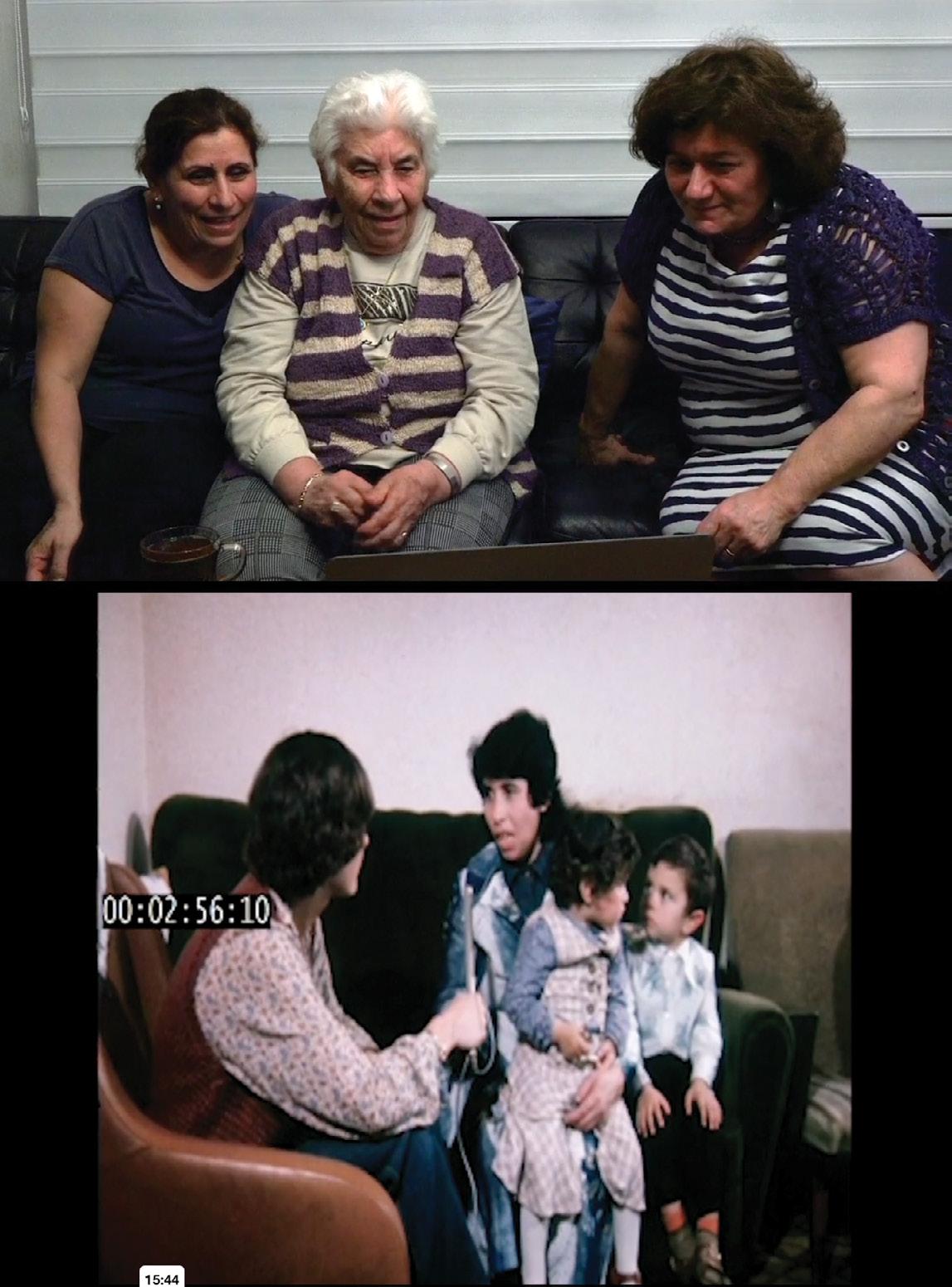
32
↑ Worker women from Turkey in front of Utrecht Courthouse, 2 October 1978.
Image credit: Telegraaf, photographer unknown.
↓ Kamile Kahraman, Şener Kahraman and Leyla İleri Razaki watching Kamile Kahraman’s TV interview from 1978, 2022. Image credit: belit sağ.
‘Embodying the Historical: the Veghel Labour Dispute’
In 1978, in two towns in the Netherlands, Veghel and Almelo, two groups of migrant women from Turkey were involved in simultaneous labour disputes. They asked their employers for collective labour agreements which would include regular work hours, higher pay, and holiday time. The realities of the labour-intensive work of plucking chicken feathers in Almelo and peeling onions in Veghel has been lost in institutional archives — only traces of these historical moments remain. Meanwhile, the former worker women I talked to voice different truths, expressed through touch, smell, jokes, movement and gossip. The somatic emerged as a method anchoring different elements in the research.
The climate crisis is a crisis of imagination of a future.1 Our ability to collectively imagine nonlinear futures is strongly tied to our ability to acknowledge multiplicities in the historical. In this way, the future is haunted by erasure of the past. The crisis of imagination of the present and the future is largely shaped by institutional archives and their acts of violence. Inspired by critical fabulation as a method2, the invitation to somatically engage with the historical and the archival attempts to destabilise past singular narratives and lead to multiple re-narrations of the Veghel labour dispute. What methodologies could foreground the embodied knowledge of migrant women workers from Turkey involved in a labour dispute in Veghel 1978, as relevant sources of historical knowledge?
In this research, I position myself as an artist facilitating spaces where a set of archival research findings and their audiences come together. I started working with the soundscape of the room where my conversation with Kamile, a former worker woman; her daughter, Şener, and one of the organisers of the dispute, Leyla, took place. In an attempt to decentralise language-based narratives I started removing all language from the soundscape which revealed an opening for the audiences to engage with what these women remember.
1 Amitav Ghosh, The Great Derangement: Climate Change and The Unthinkable (UK: Penguin UK Press, 2018).
2 Saidiya Hartman, ‘Venus in Two Acts’, Small Axe: A Caribbean Journal of Criticism 12, no. 2 (2008): 1 - 14.
Key Terms
33
Somatic Embody Non-ocularcentrism Archive Gossip Labor Collaborative Contextualize Re-enact Critical fabulation
DEEP FUTURES RESEARCH GROUP 2023 – 24 RESEARCH PROJECT
Everything I found in the archive is partial and fragmented. Through making immense timelines of what happened when, I started to form a seemingly reliable narrative of a series of events.
When the stories I find belong to people who are still alive, a question of loyalty emerges. If I follow this loyalty project I might find myself making a documentary I am not interested in making. This comes from an urge to recover what was lost or follow what the subjects of these histories want me to do. I remind myself that I can contextualise that story through focusing on a tiny spark. I do not have to tell a complete story to recover the lost pieces.
Removing language from the soundscape of the room I was in with Kamile, Şener and Leyla, in its fragmentedness, invites us toward a deep listening practice.3
First I made a linear coherent timeline as an archival instinct, then I had to do the opposite; listen to what fragments say as a fragment in their own language.
Critical fabulation is a method developed by Saidiya Hartman in order to specifically address archival absences in the Atlantic Slave Trade archives. In this project I am trying to develop my own methods specifically for the context of labour migration from Turkey to the Netherlands during the late 1970s in a small town in Brabant.
I really tried hard to find her. It took me maybe six months after I found her name in a television interview where she said she talks to the worker women daily and the claims of the factory are complete lies. She was 21 years old in that footage. It is from 1978. I wrote to every single social media account I found of her and her relatives, I did numerous online searches, wrote numerous emails, I asked every person and organisation I could think of that could potentially know of her.
Archival work is often monotonous and definitely anticlimactic.
In the end, I found Leyla on Facebook in a group photo of translators working for a translation company in Amsterdam. It must be from 2018, or 2019. Even though the only other image I had of her was from 1978, I knew it was her. I filled in the form on the website with a letter to Leyla. She hadn’t worked in that company for a while. I felt delusional filling in that form.
Her email arrived the next day. The printed still from the video interview had been hanging on the wall of my studio in front of my desk for the past several months along with all the info I found about her taped around it. She wrote: ‘I read you were looking for me. We can talk’. I went to her house and asked her many questions, and she told me her migration story. She is nervous, excited and always ready to share. There are always issues to solve and information to pass on. On that first day she gave me a driving licence exam book when I told her that I cannot drive. She said as a womxn and as a migrant I should have a driving licence and she can help me with it. Leyla was the one who put the worker women in Veghel in contact with FNV in 1978.
34 RESEARCH NOTES
unremembering nonremembering deremembering aremembering misremembering disremembering gossiping
‘Gossip presents a challenge to traditional archival conceptions of reliability’.4
When I bring this research to research groups, I often realise during the first meeting that I am the only person of colour in the group in that art, educational, institutional setting. More often than not, this never becomes a conversation if I do not initiate it. I bring images and stories of people of colour, migrant worker women, to (mostly or completely) white spaces.
As a result, the research required a clarification of my position. Currently my role is to facilitate the spaces of encounter between my research findings and their audience.
Somatic practices begin with grounding in the body. This way, people engage and ask questions from a grounded place. When confronted, they also respond from that place.
3 Pauline Oliveros, Deep Listening: A Composer’s Sound Practice (Lincoln: Deep Listening Publications, 2005), xxi-xxiii.
4 Irit Rogoff, ‘Gossip as Testimony’, Generations and Geographies in the Visual Arts: Feminist Readings (1996): 58-66.
belit sağ
MA Nonlinear Narrative tutor
belit sağ (she/they) is a visual artist, educator and researcher from Turkey based in Amsterdam. Their research-based artistic practice focuses on the role of visual representations of political violence and how they are perceived and experienced by afflicted communities. She co-founded several video-activist collectives, and an online audio-visual archive project, bak.ma. Their current research project explores the female, queer, migrant political organising, feminist solidarity and archival silences in the early period of labour migration from Turkey to the Netherlands, centering the unarchivable, intangible, and the speculative. The project investigates visual representations of lived experiences of queer and migrant communities of colour, and the ways in which somatic practice and archival research intersect. She presented aspects of this project at Sonic Acts Biennale 2024 and EYE International Archive Conference 2024. They were an artist-in-residence at Rijksakademie van Beeldende Kunsten in Amsterdam and International Studio and Curatorial Program in New York City. At KABK, belit is Theory and Thesis tutor at the Non Linear Narrative (MA) and a member of the 2023 – 24 Deep Futures Research Group run by the Design Lectorate.
35
Circling
Whether we are a moon, a planet, a satellite or a human body, we are constantly falling, always attracted by the gravitational force of a larger central body. All bodies compensate for this attraction by their velocity, the speed needed to move in a straight line. In this continual attempt to balance we are able to keep rotating in a circular orbit.
Counting
Anna Tsing, or someone like that, said that counting is noticing.
I think of a schoolteacher counting her charges back onto the bus after a visit to the Tower of London. Maybe she has a clipboard and a biro tied to it with string, or a clicker. 30, 31, 32. But there are 34 seats on the bus, she thinks, and if I am number 33, then... When did anyone last see Johnny? Anyone?
What to count, and until when. Lots of different things up to 10? Or only sheep and all the way to 480,560? Which is better for noticing, for caring? Paying attention to the
idiosyncrasies of the small group, or proffering the mass as proof?
Should I focus on the things that don’t usually get counted? How do I know? Perhaps it’s just that I don’t usually count them. But there might be whole organisations out there devoted to daily, hourly, nanosecondly monitoring of these cracks in the wall, those dandelions in a field, sad smiles at the railway station.
I do not think that once you have reached 480,560 sheep you will know or obtain something more about the world than if you had only counted 5 sheep. Rather, I think that the magic is in the act of counting; your feeling and thinking are working together, and that is where the creation of meaning lies. You need to in some way sense the things you are counting through your sensuous body, and then you need to apply a symbolic form of representations that you can add or can show accumulation of more than one thing. So perhaps it doesn’t matter what and how many,
36
but maybe only that you are doing it, that you are seeking to find those patterns, or to find wholeness — in a school bus, a meadow, or in a system.
Darkening
Refers to night, which occurs when the sun is more than 18° below the horizon. It can be described as the moment we are falling backwards away from the sunlight.
Data
Deriving from the Latin for thing given, data today is rarely ‘given’, rather it is collected, extracted, gathered, captured from a source. Furthermore, what kind of data you get is ultimately determined by what you are using to capture that data, and how you are capturing it.
Data in itself has no meaning, only through processing, analysing and interpreting can data inform us about something. Data can only become knowledge if the information it communicates fully enters our awareness in relation to our lived experience with the world around us. This is difficult since data often only informs us about one aspect or ‘feature’ of something, and has usually been collected, organised, and interpreted, from one perspective. To take data as a universal truth, would mean to disregard a situated, sensuous multiplicity of truths. Empedocles of Agrigentum said it best:|
‘Come now, with all your powers discern how each thing manifests itself, trusting no more to sight than to hearing, and no more to the echoing ear than to the tongue’s taste; rejecting none of the body’s parts that might be a means to knowledge, but attending to each particular manifestation’.
— Empedocles of Agrigentum, 484-424 B.C.
Device paradigm
The device paradigm, a term coined by Albert Borgmann, represents a way of understanding and engaging
with the world that focuses on efficiency, convenience, and immediate gratification. Devices promise to make our lives easier and more enjoyable. However, this unburdening also changes people’s connection with reality. By controlling our interactions with the real world through screens and interfaces, devices can obfuscate the true nature of the relationships we have with the real world, causing us to become alienated from the world beyond the device.
Dreaming
‘The shaman propels his awareness laterally, outward into the depths of a landscape at once both sensuous and psychological, to make contact with the living dream that we share with the soaring hawk, the spider, and a stone silently sprouting lichens on its coarse surface’.
— David Abram, The Spell of the Sensuous (New York: Vintage Books, 2017).
Dobbe
A human-made, circular sweet waterfilled pool that serves as a drinking place for livestock in the Dutch salt marsh landscape. Dobbes are protected from the salty seawater by a ring wall of earth, which also allows them to serve as high-water refuge for land animals in this intertidal area. The Dobbes are the silent eyes of this landscape, witnessing movements of the clouds above; in the night, they dream with their eyes open reflecting the moonlit sky.
Exhaustion
It’s 36°c. Savaged, sweating, I roll into the audience ‘..The NAM, Exon Mobile..!!’ I shout. Below my hands and feet lies one of the world’s largest gas-fields. Behind me a wild spaghetti of shining silver gas pipes, piercing 3000m through the soil. Sucking, fracking, mining the life out of it all. Lost in an exhaustive promise of a return to the green field, I loose my breath, frantically disguising heavy pipes in synthetic green grass.
37
Frequencies
‘Strike it, bump it, pluck it, or heat it, and it will tend to vibrate at a specific frequency. This applies to a bone, a piece of wood, a molecule, an electron, or a musical instrument
[...] In the living body, each electron, atom, chemical bond, molecule, cell, tissue, organ (and the body as a whole) has its own vibratory character [...] In terms of vibrations, the human body can be compared to a symphony orchestra. Each molecule corresponds to a particular instrument. Each bend, rotation, or stretch of a chemical bond has a certain resonant frequency, and will give off certain “notes” if it is energised […] all parts are constantly jiggling and absorbing and emitting energy [...] When two objects have similar natural frequencies, they can interact without touching; their vibrations can become coupled or resonate’.
— James L. Oschman, Energy Medicine: The Scientific Basis (Edinburgh and New York: Churchill Livingstone, 2000).
Gossiping
Deriving from the Old English terms God and sibb, originally meaning ‘godparent’, for centuries ‘gossip’ referred to female friendship. The word only gained its negative connotations later, as women friends, or so-called ‘gossips’, were deprived from gathering, were to stay at home and were excluded from the workforce. Not only was gossip — and, with it, women’s knowledge production — ridiculed, it was also criminalised; made illegal and punishable with scold-bridles, torture instruments that violently silenced and masked womens voices and faces.
Haagse Electriciteitsfabriek
Located near the heart of the city, designed by city architect
A.A Schadee, this powerplant has delivered electricity to households and businesses in the centre of The Hague since 1906. It is currently the oldest operational power plant
in the Netherlands, generating 107 megawatts, using gas-powered turbines. At first sight you couldn’t even tell that it’s running, but if you listen closely you can hear the soft hum of the transformers and glimpse the occasional puff of steam escaping from a pressure valve.
Holes
‘The formation of a black hole is a fall: a star that no longer burns collapses, compressed by its own weight; any object entering a black hole falls. What do objects do when they fall? They hit the ground and then they bounce back. At the moment when the black hole reaches the end of its fall, could it simply be that it bounces back and moves back like a ball, as if time is reversing? What do I see when I imagine myself filming the life of a black hole and playing the film backwards? Then I see a white hole. You can enter a black hole, but you can’t come out of it. With white holes, on the contrary, you can go out, but not in’.
— Carlo Rovelli, Witte Gaten Binnen de Horizon (Amsterdam: Prometheus, 2023).
Multimeter
Capturing a moment, a collection of sensations, consumption. A compression of reality into a quantifiable form. The desire to create order out of actions coming and leaving our perception. Measuring to help us find patterns. Measuring to remember. Measuring to enforce action, increase or reduce. What gets left behind, what is forgotten, repressed by the dominance of data that is collected? Who decides what is worth measuring? How does the resulting data from measurements influence our perception of reality? Is there value in forgetting, letting go? The act of measuring happens in the moment, but processing measurements is a form of history making. Describing what happened based on a set of tools that only captured glimpses of past realities.
38
Barleycorns, poppyseeds, eyelashes, ells, morgens, fathoms, hands, picas . . . such vivid parliaments of things gathered for the collective labour of pre-metric reckoning. A citizen strides though the town, a bag slung over his shoulder. I imagine them all inside, bulging and straining at the sackcloth, jostling for attention, yearning to be picked for the next dimensional assessment of a delicate unshod foot, a ploughed field, a letter, or a seabed.
Not
‘History is full of people who just didn’t. They said no thank you, turned away, ran away to the desert, stood on the streets in rags, lived in barrels, burned down their own houses, walked barefoot through town, killed their rapists, pushed away dinner, meditated into the light. Even babies refuse, and the elderly, too. All types of animals refuse: at the zoo they gaze dead-eyed through plexiglass, fling faeces at the human faces, stop having babies. Classes refuse. The poor throw their lives onto barricades. Workers slow the line. Enslaved people have always refused, poisoning the feasts, aborting the embryos. And the diligent, flamboyant jaywalkers assert themselves against traffic as the first and foremost visible, daily lesson in just not
— Anne Boyer, ‘No’, A Handbook of Disappointed Fate, (Brooklyn: Ugly Duckling Presse, 2018).
Paracetamol
‘The Global Paracetamol market is poised for significant growth between 2023 and 2029, with a positive outlook and beyond. As key players in the industry adopt effective strategies, the market is expected to expand further, presenting numerous opportunities for advancement’.
— Paracetamol Market 2023 (New Data Insights), Chemical & Material News, September 4, 2023.
Piping
In 1963 the GasUnie inserted 12,000 km of gas pipes in the Dutch soil, to
provide all Dutch households with Natural Gas. An ‘open heart surgery’ they called it. Before being buried underground, the pipes would amplify workers’ voices, in support of their communicating at pipe-distance.
‘Piping is the acoustic expression of mouse-folk normality. No one would call it art’.
— Gerard Raunig, Factories of Knowledge Industries of Creativity (Los Angeles: Semiotetxt(e), 2013).
Puppeting
If puppeteering denotes the human control of an object or another living being, then what is puppeting as an action? Puppets act at the threshold between life and death, subject and object, animate and inanimate. Puppeting is allowing yourself to walk the road of the in-between.
Raven
‘[The child] rolls the Daylight-Box around the house for several days, occasionally carrying it to the door. One day, when the people have more or less forgotten about him, he shoulders the box and makes a dash for the hole in the sky. The family gives chase but before they can catch him he slips on his raven skin and flies down to the earth. There he breaks the box and now, thanks to Raven the thief, we have daylight in this world’.
— Lewis Hyde, Trickster Makes This World; How Disruptive Imagination Creates Culture (Edinburgh: Canongate Books, 2017), 46-7.
Sensitivity
Sensitivity is like how the porosity of a sponge will determine how much water it lets in, can suck up, and how much you can squeeze out of it. Sponges have a ‘sensitivity’ to water, but that doesn’t mean they are sensitive to snow in the same way. So in that sense, sensitivity is also particular to each relationship of forces. Some sponges are very sensitive and it’s best to squeeze and not wring, as this will cause them to tear.
39
So take the wet sponge in your hand(s) and squeeze. If you treat the sponge well, it will last for years and years.
‘Becoming sensitive requires taking account of the everyday experience of being. You need to imagine how you circulate yourself “naturally” — with the necessary quotes around that word — but, in any case, imagine yourself not face-to-face with an object’.
— Bruno Latour, Culture, Cognition, and the Common Sense (Cambridge: MIT Press, 2015).
Skin
Our skin is our largest sensing organ. It is through our skin that we learn of the hardness of rock, the changes in winds, or the warmth of a body — it’s how we relate to the world. It is the last tangible layer between ‘us’ and where the rest of the world begins. But somewhere along the way we mistook this visual layer as being the absolute boundary between self and other. But our bodies do not end where our skin ends; we are not hard lines with clear cut ends and beginnings. We are more like sponges — porous and leaky.
Stuffing
A baboon from Angola
A nightingale singing nothing in a bell jar
A cat from England who used to be a family pet
A pufferfish from the Indian Ocean
Two Jack Russell Terriers riding a bike
Tight feedback and cascades
A feedback loop is created when any system’s output (action) creates an effect that feeds back into the input that triggered the action, changing how or what action is performed next. A tight feedback loop means that this process between action, effect, and re-action is extremely fast and direct. ‘Tightening’ the feedback loop is a method for increasing productivity, efficiency and accuracy, but by focusing on immediate effects it can distort our perception, blinding us
from longer, slower, more distant, cascading effects.
Uncertainty
‘Wonder, in its many forms, has provided an intellectual space—a temporary pause—which fosters the renewal of active, imaginative, emotionally engaged thinking. It depends but also thrives on the absence of certainty. It has often been associated with explicitly celebrated forms of “not-knowing”, which can make wonder suspect in the many contemporary contexts where certainty is extolled as a value — even as a human need. Understanding wonder better can alert us to the contingency, and the inadequacies, of that privileging of certainty’.
— Genevieve Lloyd, Reclaiming Wonder: After the Sublime (Edinburgh: Edinburgh University Press, 2018).
Unearthing
Many of us respond to an urge to unlearn and re-ground our understanding and reading of both our archives and our environments in relation to one another, to unearth hidden traces, exhume obstructed narratives and give ground to potential histories. Similarly . . .
‘As educators, we must admit that education was shaped as an imperial project, and we have to ask ourselves where our commitments lie. Commitment to an anti- and non-imperial mode of teaching requires offering our students the opportunity to unlearn not the past per se, but the past as a container in which many things — crimes, unruliness, refusal, repair, or other transmissions of knowledge — are being tamed. We need to unlearn the separation of the past, present, future tenses, and unlearn the future as a separate tense and site of progress. We have to help our students generate potential histories of violence, to engage
40
with different objects, people, and events, not as static moments with a “proper place” in imperial timelines but as still occurring over the half millennia of imperial rule. This unlearning is necessary in order to regain confidence in one’s own right to question the naturalization of institutional violence’.
— Ariella Aïsha Azoulay, in ‘Histories of Violence: Unlearning History’, a conversation with Brad Evans, Los Angeles Review of Books, March 2, 2020.
Un-extincting
Un-extincting is carving out an afterlife in the poetic imagination for beings we have lost. It does not attempt to bring their flesh back to life in a Jurassic Park-style experiment, but rather it feels through ways that we might sing them back into existence.
Wandering
‘The rhythm of walking generates a kind of rhythm of thinking, and the passage through a landscape echoes or stimulates the passage through a series of thoughts. This creates an odd consonance between internal and external passage, one that suggests that the mind is also a landscape of sorts and that walking is one way to traverse it. A new thought often seems like a feature of the landscape that was there all along, as though thinking were traveling rather than making. And so one aspect of the history of walking is the history of thinking made concrete — for the motions of the mind cannot be traced, but those of the feet can’.
—Rebecca Solnit, Wanderlust (London: Penguin, 2001).
Wires
There is no place in this city that has a higher density of cables. Right below my feet. I realize high voltage must be resonating through my body. The arteries needed to uphold contemporary urban existence are
altering my physiological being. Sprouting through the concrete pavement, elegant bouquets of blue cables, their tubed coats delicately cut to reveal blossoming glass fibers; a somewhat forced promise to these late-19th century residences of future realities yet to be networked, optimised. You will be connected! Why do we as a society want to be connected but without showing how? Wireless internet, wireless charging. Wireless connection is invisible to us, intangible, but nevertheless it intrudes into our personal spaces, our bodies. It feels more invasive than those connective cables we have slowly forgotten. Unaware of where it is, or how it connects A to B, I lose the sense of trust that I got from more predictable wires.
Worlding
‘Building a world in which we, the human animals, are not the main characters but part of the ensemble: “a world in which there is an eye (I) in every other”’.
—Craig Williamson, A Feast of Creatures: Anglo-Saxon RiddleSongs (Pennsylvania: University of Pennsylvania Press, 2011).
41
Fault Lines: KABK Research Forum 2024, presented by the KABK Design Lectorate Deep Futures Research Group 2023 – 24
Moderation and Research Group
chairing Alice Twemlow
Project management Bianca Meilof
Sound Alek Kurniawan
Production assistance Hana Spillerová
Production KABK Lou Top, Clara J:son Borg
Communication KABK Co Knol, Angelina Tsitoura, Evita Bruin, Mahtab Zamanifar
Facilities KABK Frans ten Bosch, Joop Bodaan
Fault Lines 2024 Identity design
Jungeun Lee and Kay Pisarowitz
Special thanks to ArtScience students: Lola Brancovich, Lila de Coninck, Jedrzej Eltman, Raphael Diederen, Wouter van den Elzen, Inge Kengen, Inga Hirsch, Bokyoung Kim, Anaïs Lossouarn, Wiggo Mott, Charlotte Roschka, Michelle O’Higgins Theilmann.
The birds, the mud, the salt marshes, the stars, Jupiter, Saturn, Venus, Sophie Dyer and Sasha Engelmann (Open-Weather), Adriana Knouf (scientist/artist), Koen van den Driesche (local astronomer), Harry Veentra (local field-guide), Het Lage Noorden and Sonic Acts.
Martha Jager, Lectorate coordinator.
Sandra Jansen and Stephan Valk for welcoming us to Het Lage Noorden, Marrum, Friesland.
Rik Komáromi, for filming us in the Royal Academy of Art Gipsenzaal, The Hague.
Arjan Kooman, for hosting us at Kooman’s Poppentheater, The Hague.
Victoria McKenzie for immersing us in somatic practice during the Veghel labour dispute research day.
Leyla Razaki İleri, Şener and Kamile Kahraman and all the worker women and their children and families who were part of the Veghel and Almelo labour disputes. All the migrant workers who fought for what they deserve in the ways they did, so that next generations enjoy that freedom and are able to push further.
Bart Vissers and all the KABK workshop instructors.
The content of this brochure was collectively written and edited by the Deep Futures Research Group 2023 – 24, with Alice Twemlow and was designed by Jungeun Lee and Kay Pisarowitz.
Typefaces Neue Montreal Paper Biotop 90g Printing Peter Print
Design Lectorate: Design and the Deep Future
The Design Lectorate, launched in September 2017, nurtures a research culture at KABK with the goal of enriching creative practices, sharpening research-informed pedagogy, and contributing to knowledge.
The project at its centre, titled ‘Design and the Deep Future’, in acknowledgement of the geologic concept of deep time, is situated at the intersection of design history, creative practice research, and the environmental humanities. It was created to prompt KABK students and staff to engage with expanded timescales and to contribute alternative imaginaries to environmental and climate justice research.
Through supervising staff research projects and sharing processes, methods and outcomes in a range of participatory and publishing initiatives, as well as providing strategies and tactics for integrating research-informed teaching in the curriculum, the Design Lectorate increases the visibility and accessibility of research within the KABK learning community and beyond.
Design Lector: Alice Twemlow lectoratedesign.kabk.nl @kabklectoratedesign
